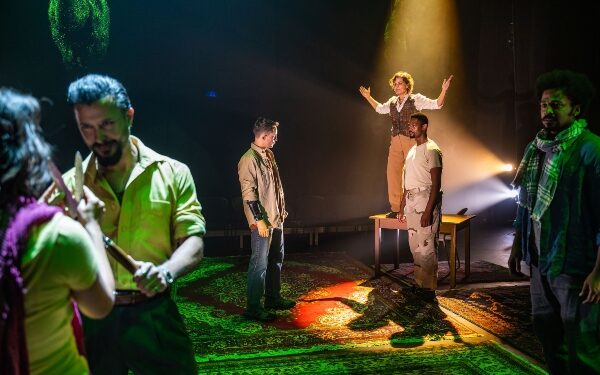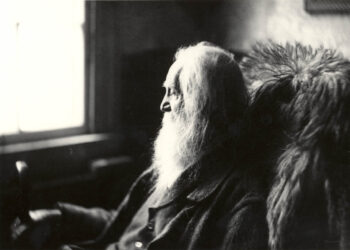Table of Contents
ToggleIntroduction
Bengal Tiger At The Baghdad Zoo Summary By Rajiv Joseph Rajiv Joseph wrote the drama Bengal Tiger at the Baghdad Zoo, which had its premiere in 2009. The 2003 Iraq War serves as the backdrop for the play’s exploration of the tragedies and absurdities of war, identity, and humanity. The drama emphasizes the conflict between survival, morality, and the weight of history through its dark humor, mythological allusions, and in-depth examination of human nature.
A Bengal tiger that has escaped from its cage and is used as both a character with a voice and a metaphor of the chaos of war in the play, which is set at the war-torn Baghdad Zoo. The tiger, both literally and figuratively, struggles with its innate inclinations and the human environment. In addition to the tiger, the play features a number of other characters, including American soldiers, Iraqi citizens, and a ghost, all of whom are influenced by trauma, grief, and violence and who end up in perilous positions.
The relationships between the characters and their attempts to deal with the difficulties of life during the continuous war are at the center of the narrative. The tiger is more than just an animal; it represents the atrocities of war, the ridiculousness of violence, and the search for purpose in an apparently meaningless world.
Summary of Bengal Tiger at the Baghdad Zoo
The events of Bengal Tiger at the Baghdad Zoo take place in 2003, during the Iraq War, amid the destruction brought about by the invasion of Iraq by American forces. The drama begins with a Bengal tiger that has broken out of its cage in the Baghdad Zoo. The conflict has turned the zoo, which was once a place of beauty and life, into a place of death. Once a representation of strength and grandeur, the tiger is today a wounded and perplexed animal attempting to make sense of its environment.
In the zoo, the tiger encounters several human characters, including two American soldiers — Tom and Kev — and an Iraqi man named Musa. Tom and Kev, who are stationed at the zoo during the invasion, are responsible for guarding the place. They are portrayed as bored, confused, and detached from the destruction happening around them, but they also deal with their own internal conflicts related to their roles in the war.
Read more
Musa, a civilian employee of the zoo, is an Iraqi gardener. He has a complicated relationship with the soldiers and is profoundly impacted by the war’s carnage. Musa gradually becomes unexpectedly entangled in Tom and Kev’s lives, demonstrating how the war affects people of all nationalities.
An other significant character in the story is the ghost of Zara, a young Iraqi woman. The zoo is haunted by the spirit of Zara, who was killed during the invasion. In her interactions with the surviving characters, she makes observations about the war and the negative effects of violence. Because Zara symbolizes the pain of innumerable innocent individuals impacted by the battle, her presence confuses the play’s moral terrain.
The tiger finds it difficult to comprehend its position in a violent and uncertain environment as the characters deal with their trauma, shame, and grief. The tiger’s conflict with the troops and its internal conflict come to a head in a pivotal scene. The audience is left to consider the moral dilemmas brought up by the war and the unresolved conflicts in the characters’ lives as the play finishes on an ambiguous note.
Joseph weaves together dark comedy, sorrow, and surrealism throughout the play to produce a nuanced and provocative story. The juxtaposition of the tiger’s mythological status with the brutal realities of war underscores the play’s central themes of violence, dehumanization, and the search for meaning.

Themes in Bengal Tiger at the Baghdad Zoo
1. The Absurdity of War:
The ridiculousness of war is one of the main themes of Bengal Tiger at the Baghdad Zoo. The needless carnage, devastation, and bewilderment that war causes to both the soldiers and the civilians left in its wake are highlighted in the play. The zoo’s environment, which was once a tranquil haven for animals but is now a representation of chaos and death, emphasizes how life is diminished during times of war.
Both military and civilians are depicted as being caught in an unjustifiable cycle of violence from which it is hard to break free. Once a magnificent animal, the tiger now represents how war destroys everything, even nature, and leaves it in a damaged and unrecognizable state.Bengal Tiger At The Baghdad Zoo Summary By Rajiv Joseph
The characters’ actions also reflect the ridiculousness. For example, the battle bores Tom and Kev. They have a detached approach to the matter, taking pleasure in insignificant things like playing with a bomb or murdering a cat. The dehumanizing impact of battle, when morality becomes hazy, is highlighted by their detachment from the seriousness of their circumstances.Bengal Tiger At The Baghdad Zoo Summary By Rajiv Joseph
2. Identity and Dehumanization:
Bengal Tiger At The Baghdad Zoo Summary By Rajiv Joseph The subject of identity is also explored in the play, specifically how violence and war deprive people of their humanity. For the tiger, the struggle is about more than just survival; it’s about what it means to be a tiger in a violent and destructive world. Despite being a real animal, the tiger serves as a metaphor for how people lose their identity when forced to adapt in ways that are not natural to them during a battle. Torn between their positions as survivors, victims, and soldiers, the protagonists struggle with their own identities.
Bengal Tiger At The Baghdad Zoo Summary By Rajiv Joseph The conflict has a significant impact on the troops’ sense of self. They are presented as people who were formerly regular humans but have since been degraded to weapons of destruction and violence. Their emotional conflicts and the intricacy of their own morality are revealed through their encounters with the tiger and the Iraqi villagers. Their apparent disregard for the brutality they participate in, which exposes the deterioration of their morals in the face of ruthless conflict, emphasizes the troops’ dehumanization even further.
Zara and Musa also stand for the loss of identity. Musa battles the moral difficulty of his position as a civilian torn between his need to survive and his allegiance to his nation. As a ghost, Zara represents the innumerable innocent souls lost during the conflict—people who are made invisible in the larger scheme of things. She forces the soldiers to face the consequences of their aggression by presenting them with the truth about what they have done.Bengal Tiger At The Baghdad Zoo Summary By Rajiv Joseph
Read more
3. Trauma and Memory:
Characters in the play struggle to deal with the violence they have watched and experienced, making trauma another important issue. The conflict has left both troops and civilians scarred, and their acts are frequently driven by a desire to forget or accept what they have experienced. Because it has been compelled to live in a conflict zone, the tiger has experienced psychological as well as physical trauma, and this has influenced its behavior.
The horrific recollections of the conflict are embodied by Zara’s spirit. Being a victim of the invasion, she is unable to escape the horror of her terrible demise and lives in a state of transition between life and death. She acts as a reminder of the psychological and emotional damage that war causes, particularly to those who are left in its wake. The other characters use facing Zara’s spirit as a means of dealing with their own sorrow and remorse.Bengal Tiger At The Baghdad Zoo Summary By Rajiv Joseph
4. The Search for Meaning:
The play’s central theme is the pursuit of meaning in a violent and war-torn planet. The human characters, who are likewise looking for meaning in the midst of chaos, share the tiger’s longing to comprehend its existence and discover purpose. The play implies that people frequently resort to myth, comedy, or even violence to find meaning where none is found when confronted with enormous devastation.Bengal Tiger At The Baghdad Zoo Summary By Rajiv Joseph
In its discussions with the other characters, the tiger poses queries concerning purpose, death, and life. The fundamental human drive to make sense of the world, even when it seems meaningless, is reflected in its quest for understanding. The characters in the play, particularly the soldiers and the ghost of Zara, are all on their own quests for meaning — whether it be through their actions, their relationships, or their attempts to escape the past. Bengal Tiger At The Baghdad Zoo Summary By Rajiv Joseph
5. The Power of the Supernatural:
Bengal Tiger At The Baghdad Zoo Summary By Rajiv Joseph Bengal Tiger at the Baghdad Zoo’s supernatural components serve as a prism through which the drama examines morality and repercussion. The most noticeable supernatural component in the play is Zara’s ghost, whose presence draws attention to the psychological and spiritual effects of violence. The protagonists are forced to face the actual repercussions of their deeds and their part in the cycle of violence as a result of the ghost’s encounters with them.
The way the tiger interacts with the people around it also gives it a slightly otherworldly appearance. A layer of mythology is added to the drama by the tiger’s capacity to speak, its philosophical reflections, and its battle to survive in a conflict zone, all of which establish it as a character that transcends the natural world.
Bengal Tiger At The Baghdad Zoo Summary By Rajiv Joseph The characters’ perception of reality is called into question by this otherworldly presence, which also forces them to consider the moral ramifications of their choices.Bengal Tiger At The Baghdad Zoo Summary By Rajiv Joseph

Conclusion
Bengal Tiger At The Baghdad Zoo Summary By Rajiv Joseph The play Bengal Tiger at the Baghdad Zoo examines the horrors and absurdities of war in a way that is both emotionally deep and thought-provoking. Rajiv Joseph creates a story that explores issues of violence, trauma, identity, and the pursuit of meaning in depth through the tiger as a symbol, the characters’ hardships, and the interaction of supernatural elements.Bengal Tiger At The Baghdad Zoo Summary By Rajiv Joseph
The drama challenges viewers to address the moral difficulties that emerge during times of warfare while also encouraging them to consider the dehumanizing impacts of war. Bengal Tiger at the Baghdad Zoo is ultimately a potent reflection on the effects of violence and the desire for atonement.Bengal Tiger At The Baghdad Zoo Summary By Rajiv Joseph
Read more
Q1: What is the significance of the Bengal tiger in the play?
The Bengal tiger serves as both a literal and symbolic figure in the play. As an animal caught in the chaos of the Iraq War, the tiger symbolizes the brutality and absurdity of war. Its struggle to survive in a violent, war-torn world reflects the dehumanizing effects of conflict. Additionally, the tiger’s philosophical musings and existential questions add a layer of complexity to the narrative, prompting the audience to reflect on themes of identity, trauma, and the search for meaning.
Q2: How does the character of Zara contribute to the play’s themes?
Zara’s ghost represents the countless innocent victims of the war, whose lives are erased from the dominant narratives of history. Her presence serves to confront the soldiers with the reality of their violence and challenges them to face their guilt and the consequences of their actions. Zara’s ghost also embodies the theme of trauma, as she is unable to move on from the violence of her death. Her interactions with the characters bring the theme of memory and consequence to the forefront of the play.
Q3: What is the role of dark humor in Bengal Tiger at the Baghdad Zoo?
Dark humor plays a critical role in Bengal Tiger at the Baghdad Zoo, helping to underscore the absurdity of war and the psychological coping mechanisms of the characters. The humor often emerges in moments of tension or violence, providing a sharp contrast to the grave realities being depicted.
This juxtaposition of humor and tragedy forces the audience to confront the complexities of the human experience in the context of war.Bengal Tiger At The Baghdad Zoo Summary By Rajiv Joseph
Q4: What does the play suggest about the morality of war?
Bengal Tiger at the Baghdad Zoo questions the morality of war by depicting the soldiers and civilians as morally ambiguous characters. The play does not present a clear-cut view of right and wrong but instead focuses on the internal struggles of the characters as they grapple with their roles in the conflict. The play suggests that war is a dehumanizing force that erodes moral clarity, leaving individuals to navigate a world where survival and violence often blur the lines between good and evil.
Q5: How does Rajiv Joseph use symbolism in the play?
Joseph uses symbolism extensively throughout Bengal Tiger at the Baghdad Zoo. The tiger itself is a powerful symbol of both nature and war, representing strength, survival, and the inherent violence of the conflict. Zara’s ghost symbolizes the human cost of war, while the zoo, once a place of life and tranquility, serves as a metaphor for a world turned upside down by violence. Through these symbols, Joseph invites the audience to reflect on the broader implications of war and the human condition.
Read more

















